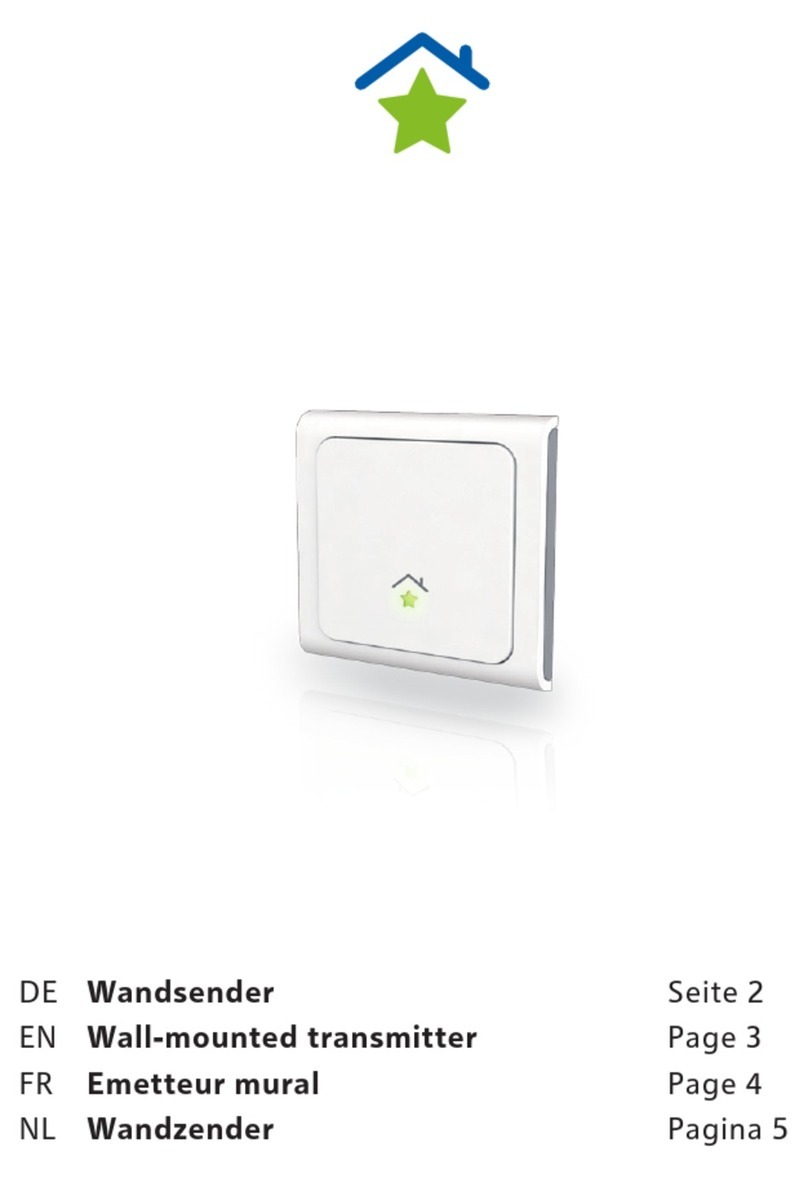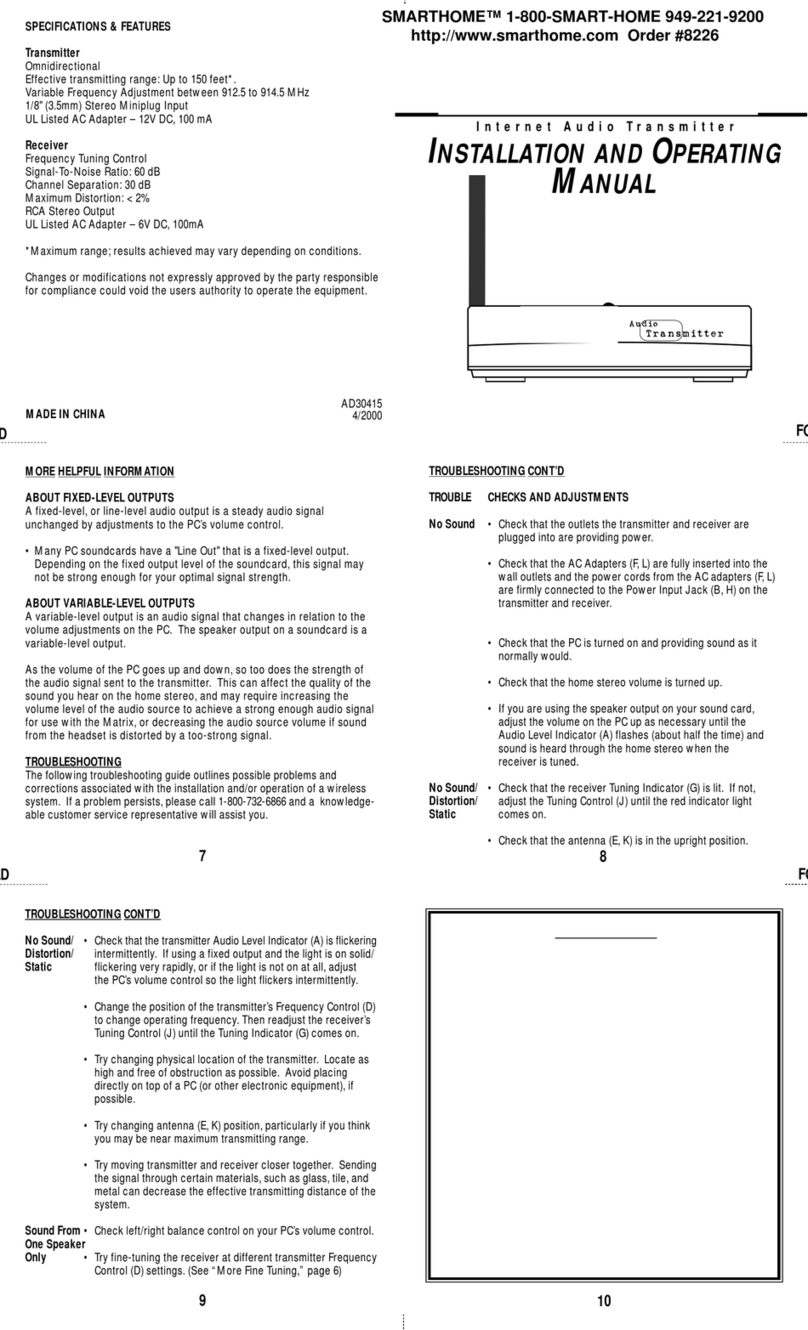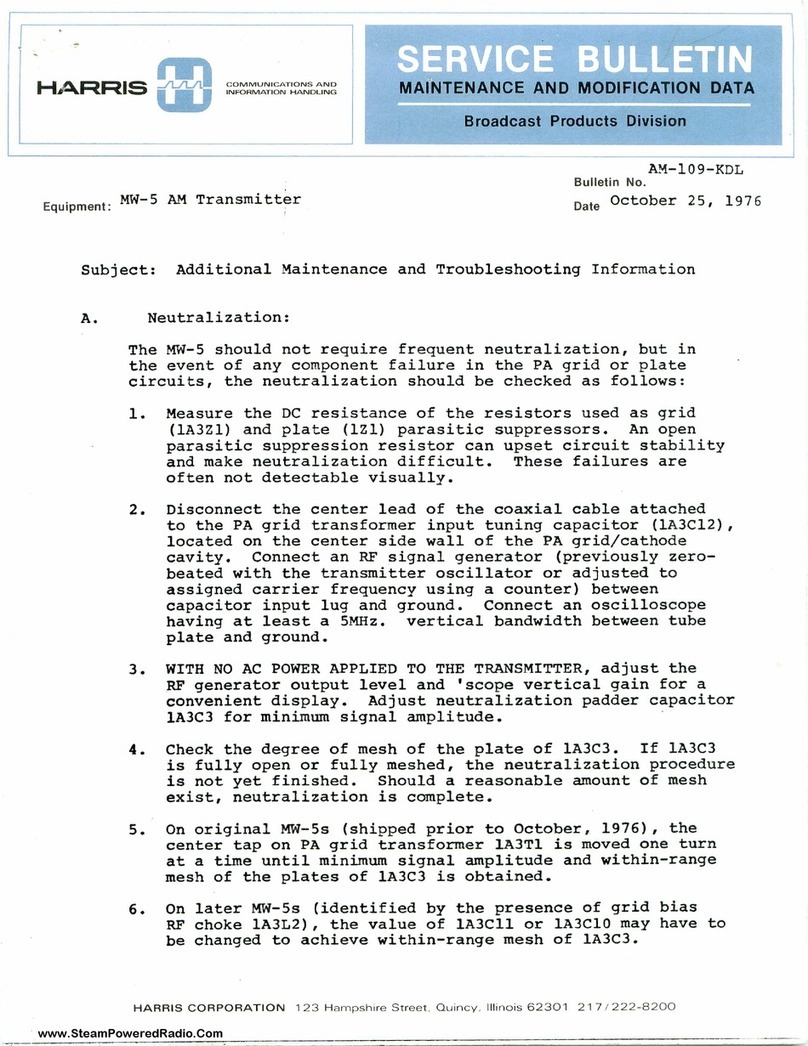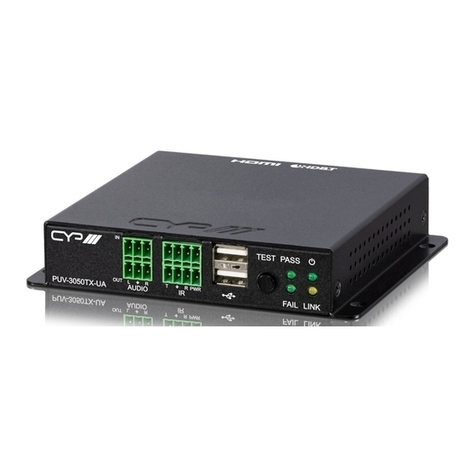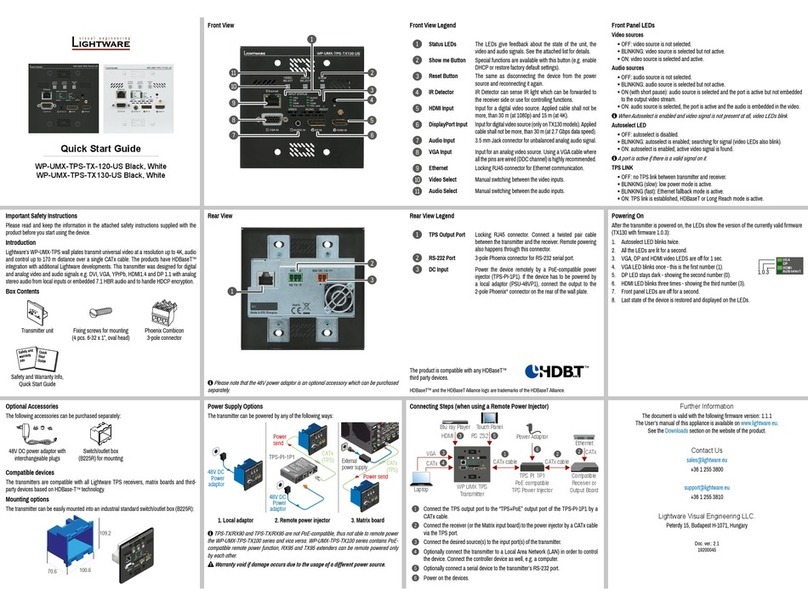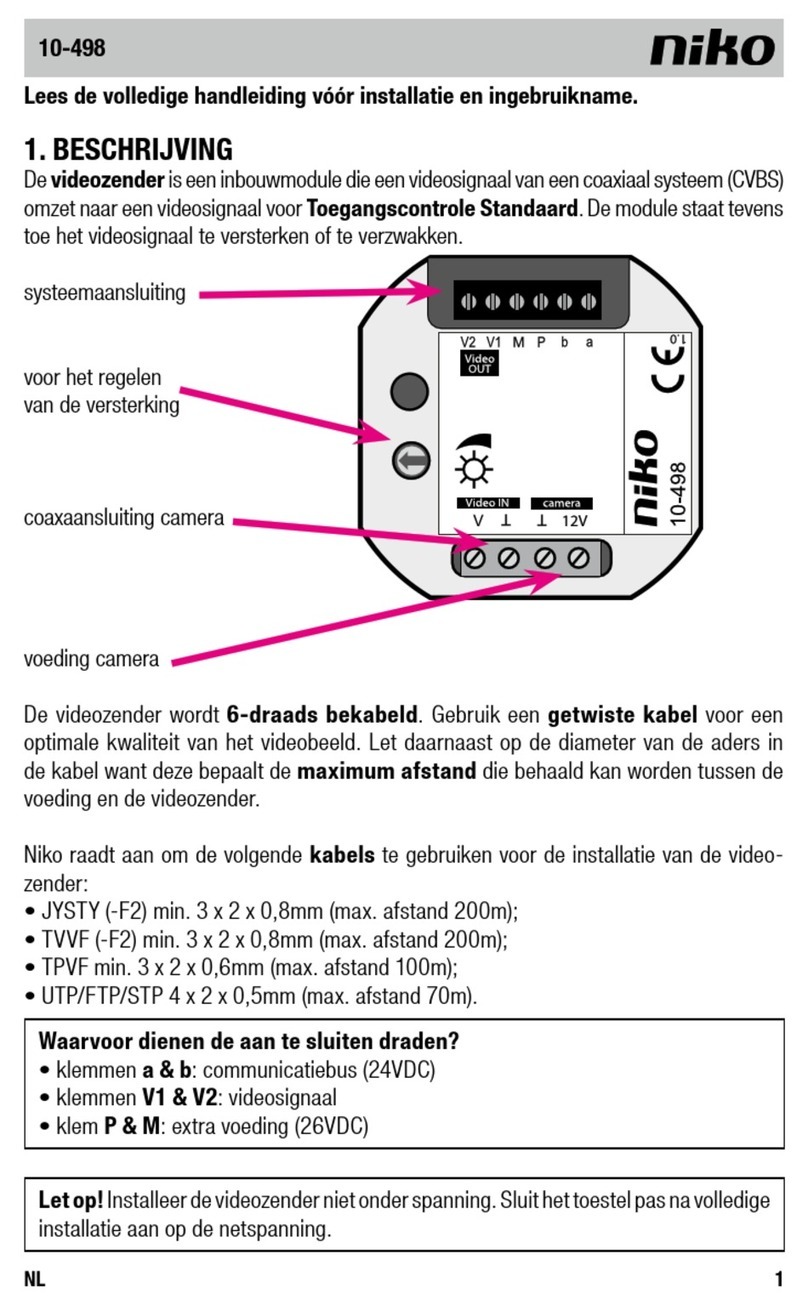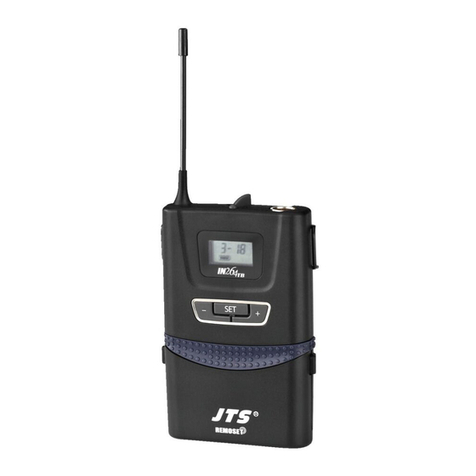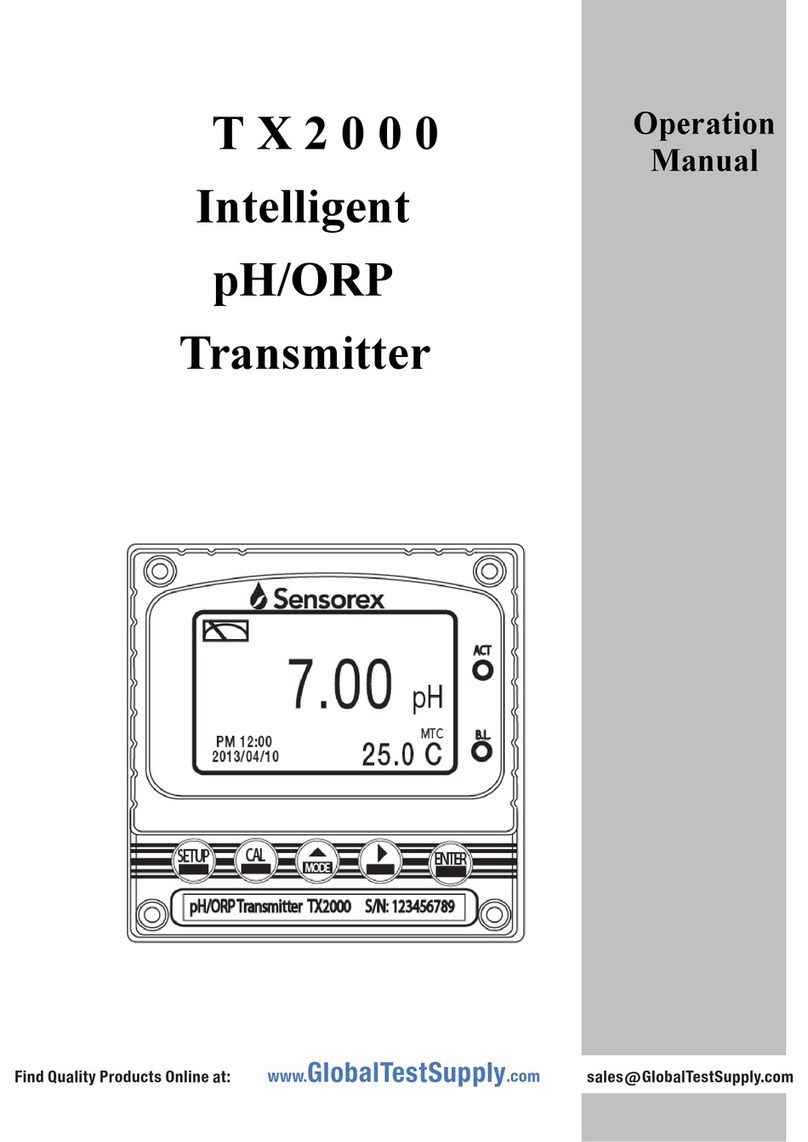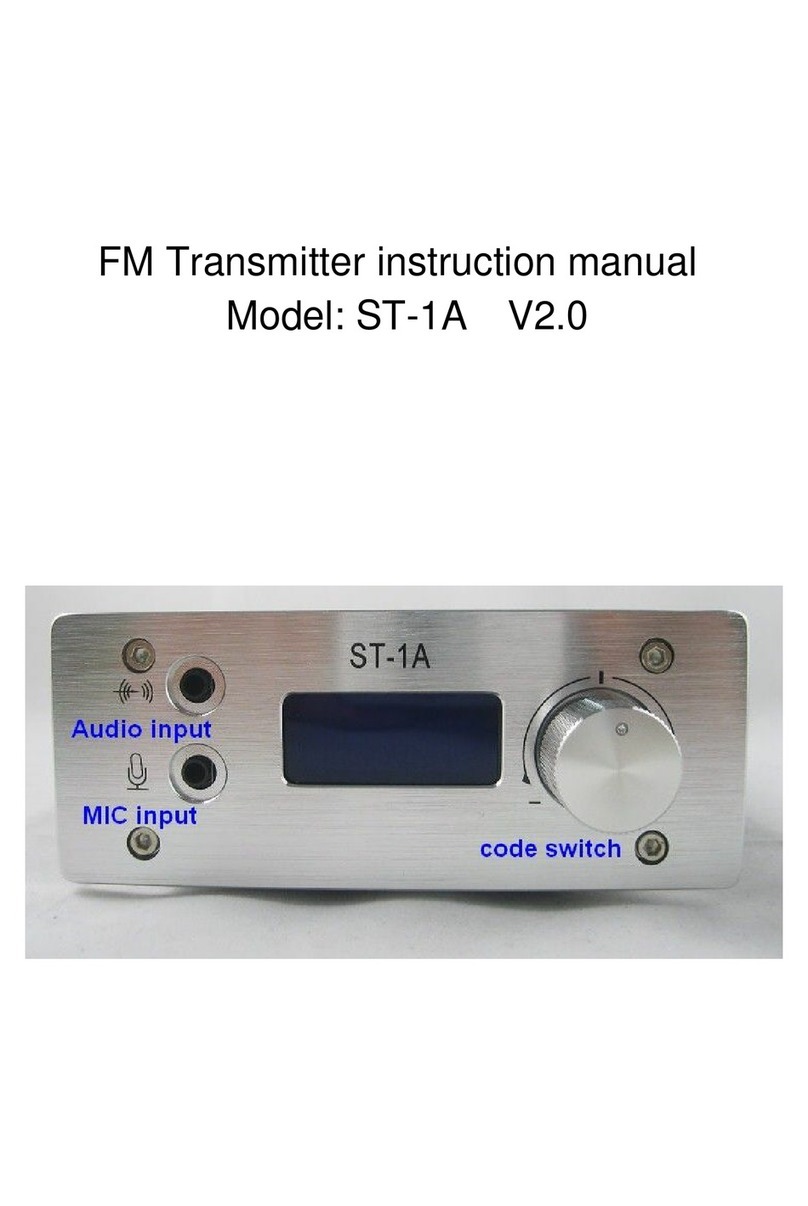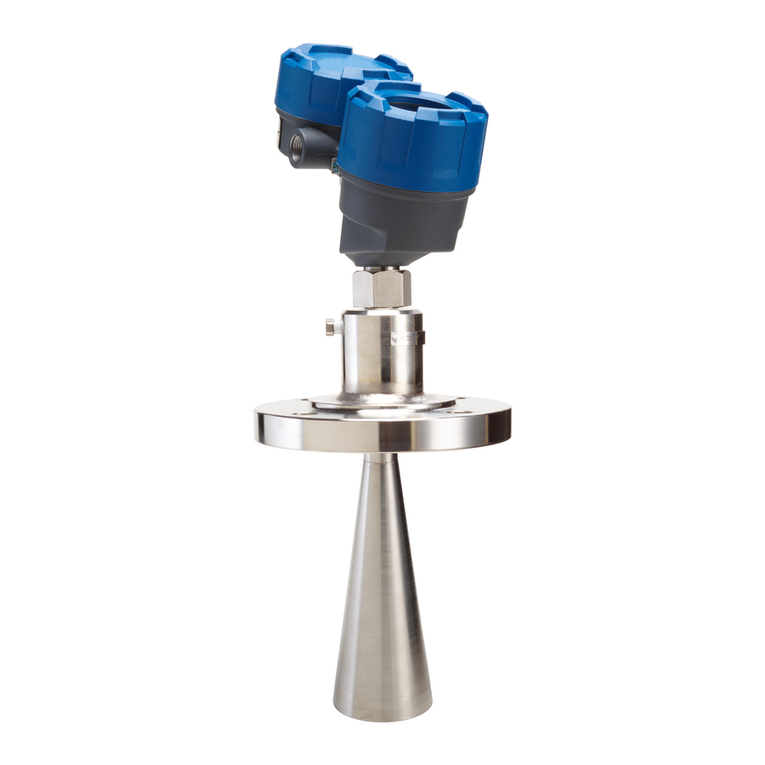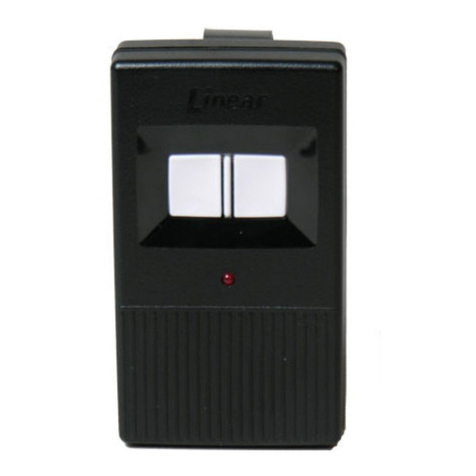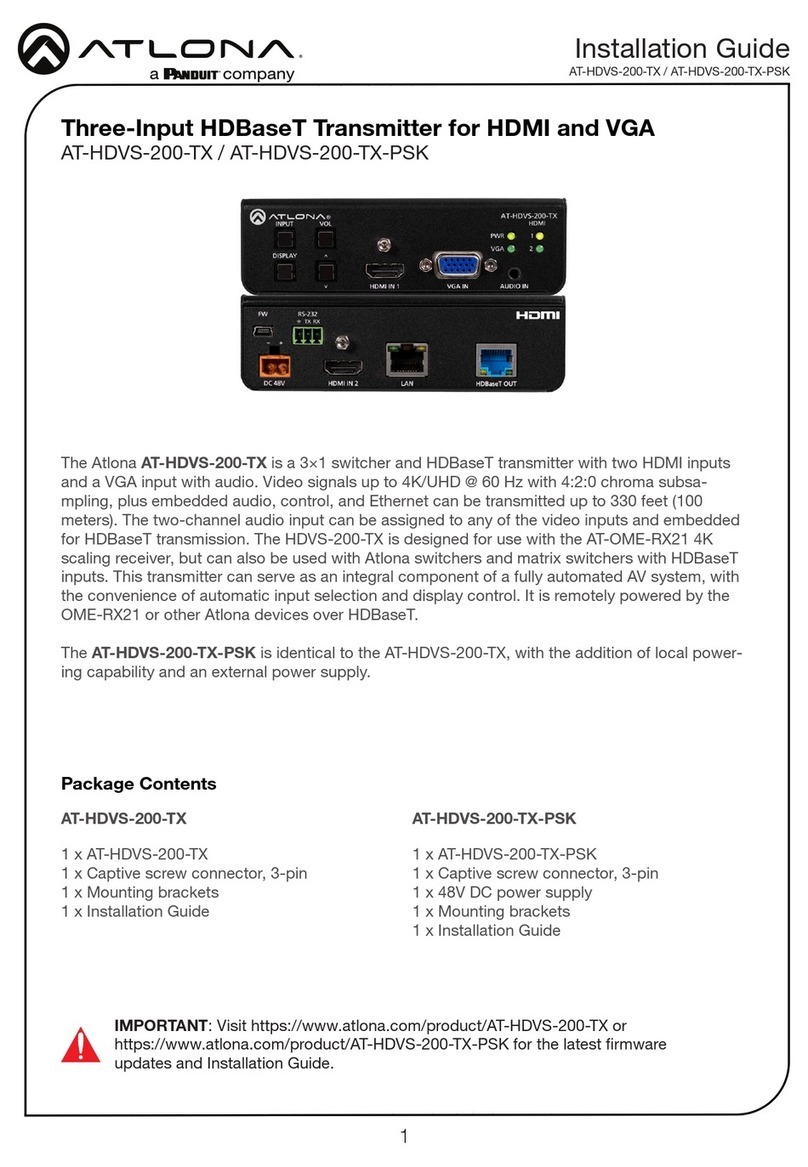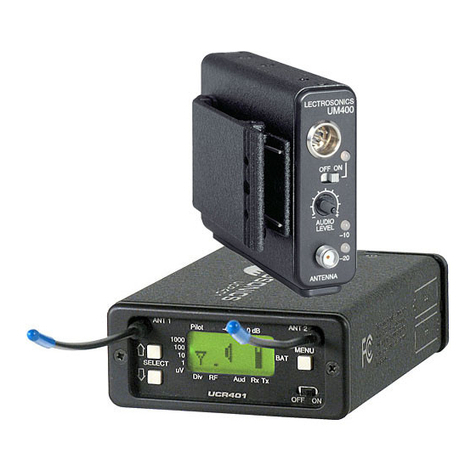smart home SwitchLinc 12080W User manual

SwitchLinc
Transmitter
Remote Control Transmitter
MANUAL
For models:
12080W SwitchLinc Transmitter in White
12080I SwitchLinc Transmitter in Ivory
TM
12080_web.qxd 6/25/2004 1:30 PM Page 1

Congratulations!
Thanks for purchasing the SwitchLincTM Transmitter for your home automation project.
SwitchLinc Transmitter is a product we've been asked about for years, a simple transmitter
of X10/PLC signals that's intuitive to use. It is built upon the second generation
SwitchLinc 2-Way platform and many of the functions are identical.
SwitchLinc Transmitter is just like our other SwitchLinc products, except it can’t directly
control a load or set of lights. As a dedicated transmitter, it can be used to control other
SwitchLincs, KeypadLincsTM, and many other Smarthome Design and compatible products.
It can activate lighting "scenes" or trigger home automation "events".
SwitchLinc Transmitter has an eight-LED brightness bar that will indicate the lighting level
at the receiver. Additionally, the unit will receive and understand signals from other trans-
mitters on its primary address and display the results on the brightness bar. All the pro-
gramming, like the X10/PLC address is electronically set; there are no code wheels to
adjust. It is easily installed and programmed. It mounts into a standard North American
wall box.
Key Features
• True rocker action
(top = on/bright, bottom = off/dim)
• 2-Way communications
• 8-level LED “Bar” shows brightness of circuit
• High quality micro switches give the user tactile feedback
when pressed (no mushy feel)
• All settings are held in non-volatile memory (no code wheels to set)
• Illuminated Status LED/ Set Button
Other SwitchLinc Models
SwitchLinc 2-Way Dimmer #2380W/I - (White or Ivory)
SwitchLinc 2-Way 1000-watt Dimmer #2381W/I - (White or Ivory)
SwitchLinc 2-Way Relay with BoosterLinc #23883W/I - (White or Ivory)
SwitchLinc 2-Way Timer Relay with BoosterLinc#23883W/I - (White or Ivory)
SwitchLinc Plus Dimmer #2386W/I - (White or Ivory)
SwitchLinc PLC Dimmer #2384W/I - (White or Ivory)
SwitchLinc Relay PLC #23885W/I - (White or Ivory)
SwitchLinc Deluxe Dimmer (No PowerLine Control) #2387W/I - (White or Ivory)
SwitchLinc Multi-Way Companion Switch for 3-Way circuits #2382W/I - (White or Ivory)
Brightness LED “Bar”
Status LED/Set Button
and Nightlight
Other Smarthome
Products
Your SwitchLinc Transmitter
is compatible with many of
our other home automation
products. If you need tradi-
tional-looking wall switches,
check out the new
ToggleLincTM series of wall
switches or the new
SwitchLinc RX, which is
ideal for retrofit applications where there isn't a neutral wire at the switch's wall box. The
KeypadLinc Wall Mounted Transmitter allows you to control multiple devices from one
location at the press of a single button. And for plug-in devices, the ApplianceLincTM and
LampLincTM modules will automate just about anything that plugs in. Please visit the
Smarthome web site or contact your distributor for more information.
2
12080_web.qxd 6/25/2004 1:31 PM Page 2

CAUTION!!
Read and understand these instructions before installing. This device is intended for installa-
tion in accordance with the National Electric Code and local regulations in the United States, or
the Canadian Electrical Code and local regulations in Canada. To reduce the risk of overheating
and possible damage to other equipment, do not install a SwitchLinc to control a receptacle or
fluorescent lighting fixture. For indoor use only. Connect only copper or copper-clad wire to this
device. Before installing, disconnect power at circuit breaker or remove fuse to avoid shock or
damage to the control. It is recommended that a qualified electrician perform this installation.
Retain these instructions for future reference.
Quick Start Instructions DEFAULT
Setting the Transmitter’s 1. Press and hold the Set Button for 3 A-1
Primary Address seconds (the LED will begin blinking)
2. Send the desired address from any
transmitter within 30 seconds
(see page 5 for more detailed instructions)
Factory Reset 1. Gently pull the Set Button out
to remove power for 5 seconds
2. Push and hold in the Set Button Resets to
for 5 seconds, then release default
3. When the LED Indicator comes on, settings
the SwitchLinc Transmitter is reset
(see page 6 for more detailed instructions)
Preparation
Before installing the SwitchLinc Transmitter, please take the necessary precautions
listed here:
• Be sure that the fuse has been removed or the circuit breaker is turned off to the
circuit being controlled. Installing the SwitchLinc Transmitter with the power on
will expose you to dangerous voltages.
• The Wiring Diagram on page 5 will help you to determine the wire colors of the
connections to the SwitchLinc Transmitter and Multi-Way Companion Switch.
Note: While the neutral connection is optional on the Multi-Way Companion
Switch, the SwitchLinc Transmitter requires a neutral connection.
• Wiring for 3-way, 4-way, & up switch circuits follow conventional (standard, non-
remote) wiring practice (plus the requirement for a neutral). Wiring the
SwitchLinc Multi-Way Companion Switch requires the Line (Black) wire be acces-
sible and be the same 110V leg of the house wiring. The White wire on the
Multi-Way Companion Switch is connected to NEUTRAL ONLY. If neutral is not
available, cap the White wire, which will simply causes the nightlight LED not to
function.
• Installation should be performed only by a qualified electrician, or by a homeown-
er who is familiar and comfortable with electrical circuitry. If there are any ques-
tions, consult an electrician or contact Smarthome's Tech Support department
for guidance.
3
12080_web.qxd 6/25/2004 1:31 PM Page 3

Step-by-Step Instructions
1. Disconnect the power at the circuit breaker or fuse panel. Verify that the power has
been removed by testing the wires for voltage.
2. Remove the trim plate from the existing switches.
3. Unscrew and pull the existing switches from the wall box.
4. Disconnect the wires from the existing switches.
5. If the SwitchLinc Transmitter is being installed into a
3/4/5-way circuit, the SwitchLinc Multi-way Companion
Switch must be installed in the wall box where power
comes into the circuit. Follow the instructions included
with the Multi-way Companion Switch to identify the "Hot,"
"Neutral," "Ground," and "Traveler" wires.
6. Orient SwitchLinc Transmitter so the LED is at the top and make connections
according to the “SwitchLinc Transmitter Wiring Diagram”. Wire Multi-way
Companion Switches (if used) according to the “SwitchLinc Transmitter Multi-Way
Wiring Diagram”.
7. After all connections have been made, ensure that all wire connectors are firmly
attached and that there is no exposed copper except for the Ground wire.
8. Gently place the wires and switch into the wall box (with LED at top) and screw into
place.
9. Turn the circuit breaker back on.
10. The Status LED/ Set Button will illuminate with a steady green glow.
12. After testing SwitchLinc Transmitter for proper operation, install the faceplate (sold
separately).
Tip: For additional
help installing 3-way
circuits, see page 5 in
the Multi-way
Companion Switch
manual.
4
12080_web.qxd 6/25/2004 1:31 PM Page 4

Setting the Primary Address
Each SwitchLinc Transmitter will require a PLC address that it will transmit when acti-
vated. It ships from the factory with “A1” as the default address; it will also have this
address after performing a factory reset. Any of the 256 PLC/X10 addresses can be
programmed.
The SwitchLinc Transmitter does not use code wheels or dials to set its primary
address. Instead, it will accept the first PLC address it finds on the powerline once the
programming mode is started. Any PLC/X10 transmitter can
be used to set the primary address.
Important: If you plan on sending status requests to the
SwitchLinc Transmitter, make sure that no other 2-Way
device is programmed to the same primary address.
Otherwise, their simultaneous responses to a status
request will collide with one another.
1. Using the tip of a very small screwdriver, press and hold
the Status LED/ Set Button for approximately 3 seconds
then release. The green Status LED/ Set Button will
begin blinking.
2. Within 30 seconds, transmit the desired primary address
(housecode and unit code) from any transmitter.
TheStatusLED/SetButtonwillstopflashing.
3. Confirm that the address was accepted by manually
activating the SwitchLinc transmitter and observing
if the signal activated a receiver.
Tip:
If you have trouble
communicating to the
SwitchLinc, there may
be a lot of X10 activity
on the powerline.
Unplug transmitters
that send signals that
might be intercepted by
SwitchLinc during the
programming
sequences. RF
transceivers, computer
controllers, and X10
thermostats should be
unplugged to avoid
interference.
5
Using SwitchLinc Transmitter
Input at Switch PLC Transmission Example
Double-tap
top of rocker Housecode & Unit Code (once)
Housecode & ON (twice) A1 - Aon - Aon
Triple-tap
top of rocker Housecode & Unit Code (once)
Housecode & ON (three times) A1 - Aon - Aon - Aon
Double-tap
bottom of rocker Housecode & Unit Code (once)
Housecode & OFF (twice) A1 - Aoff - Aoff
Triple-tap
bottom of rocker Housecode & Unit Code (once)
Housecode & OFF (three times) A1 - Aoff - Aoff - Aoff
Advanced Operations
Input at Switch PLC Transmission Example
Tap top of rocker
(when light is off) Housecode & Unit Code
Housecode & ON A1 - Aon
Tap top of rocker
(when light is on) Housecode & Unit Code
Housecode & ON A1 - Aon
Press & hold
top of rocker Housecode & Unit Code
Preset Dim Level A1 - A predim 50%
Tap bottom
of rocker Housecode & Unit Code
Housecode & OFF A1 - Aoff
Press & Hold
bottom of rocker Housecode & Unit Code
Preset Dim Level A1 - A predim 50%
Basic Operations
12080_web.qxd 6/25/2004 1:31 PM Page 5

Other Options
Factory Reset
If the SwitchLinc Transmitter begins to operate strangely, the factory reset procedure
can be used to clear the EEPROM's memory and restore its factory default settings.
1. Gently pull out the Status LED/ Set Button on the SwitchLinc Transmitter until a
click is heard. This completely removes the power from the SwitchLinc Transmitter.
2. Wait five seconds, push in and hold in the Status LED/ Set Button.
3. Release the Status LED/ Set Button after five seconds.
4. WAIT approximately 25 seconds. During this time, the Status LED/ Set Button will
remain off. The reset procedure is complete when the Status LED/ Set Button illu-
minates.
Disable Programming
Once the SwitchLinc Transmitter is set up, it can be programmed to lockout any
changes. Attempts to change the programming will be ignored. Please note that all
SwitchLincs, LampLincs, and KeypadLincs that are plugged in or electrically active will
receive these commands and also be locked out.
1. Send the following command sequence to disable the programming:
Re-Enable Programming (default is enabled)
1. Send the following command sequence to enable programming:
How Powerline Signals Travel Around A Home
and How To Improve Reliability
Most homes in North America have two lines of 120 volts coming into the home from
the utility company. This split-single phase electricity is divided out at the home’s
breaker box into the circuits that feed light switches, plug-in outlets, and appliances.
Half of the electricity outlets and wall switches are fed by one of the 120-volt lines and
the second 120-volt line feeds the other half. The intermittent operation of PLC/X10
modules usually happens when the transmitter is sending signals on one line and the
receiver module is plugged into an outlet on the other line. For the signals to get to
the receiver, it must leave the home, travel to the utility
company transformer then come back in on the other AC
line. By the time the signal gets back to the home, travels
through the electrical meter and circuit breaker box, there
may not be enough signal left to trigger the module.
The first order of business will be to install a coupler-
repeater, also known as amplifier. A coupler-repeater will
‘see’ the incoming signal, re-generate it, and blast it out
over both lines of the 120 volts. We recommend that any
home larger than 3000 square feet install a coupler-
repeater. In smaller homes, a passive phase coupler also
known as a signal bridge may give satisfactory results.
6
M16 O16 P16 N16 P16
N16 M16 O16 P16 P16
#4826B
SignaLincTM Repeater
12080_web.qxd 6/25/2004 1:31 PM Page 6

7
Smarthome’s BoosterLinc™can solve localized problems
SignaLinc Repeater is ideal for improving the home
automation signal strength throughout all the out-
lets in a home. But, as the PLC signals travel down
a circuit and away from the repeater, it will weaken
by the same factors listed above. Additionally, the
signal will get weaker as it passes installed PLC
transmitters. Each PLC transmitter contains a
tuned circuit that when it's not sending signals it's
absorbing them! In addition to plug-in transmitters,
LampLinc™ 2-Ways, SwitchLinc™ 2-Ways,
ToggleLinc™ 2-Ways, ApplianceLinc™ 2-Ways,
KeypadLinc™ Controllers, or any module with 2-way abilities will load down the avail-
able signal. With so many transmitters installed, the signal is loaded down to a
point where some modules will be unable to receive a signal. Installing multiple 2-
way devices on one branch circuit may necessitate the use of local amplifier like
Smarthome's BoosterLinc.
#4827 BoosterLinc
TM
Plug-In Amplifier
How To Improve Reliability (continued)
Once the signal has been amplified, it’s time to preserve it. Since PLC signals go
everywhere in the home, some electrical devices will have more of an effect on the
signal strength than other devices. PLC signals are like water pressure in pipes, it
actually goes everywhere it can, not just to the receiving module. In the last 20
years, an explosion of electrical devices has invaded our homes. Computers, video
gear, and fancy high-end electronics are more present than in years past. The more
complicated the electrical power supply is in a device, the more likely it is to absorb
PLC signals. Engineers who design power supplies build in traps to filter out and kill
electrical noise. Unfortunately, the PLC signals looks like electrical noise to these
devices. The result is that a large percent of the transmitted signal is lost to these
devices leaving less for the receivers. The most common sources of signal loss are:
• Televisions • Computer systems
• Audio/Video gear • Computer UPS's and power strips
• Power supplies for laptops and cell phones
Testing for the problem is simple. If a device is suspected of
causing signal absorption, unplug the device and then re-
transmit the signal. It is very important that the device is
unplugged and not just turned off! If the controlled product
begins working after the appliance is unplugged, then a filter
will be needed on that device to keep PLC signals from being
absorbed and raise the signal strength of the entire home.
Smarthome has many filters that will fix the problem. An aver-
age home will need between three and five filters. If you are
in the business of installing automation systems and not in
the ‘call-back’ business, include some of these in your bid as
part of the standard package. #1626 FilterLincTM
Plug-In Filter
12080_web.qxd 6/25/2004 1:31 PM Page 7

Helpful Tools
If you’re investing in home automation, there are a few tools that will make your projects run smoother:
Maxi-Controller
This plug-in transmitter has the ability to send individual PLC commands. The but-
tons are separated into Addresses and Command functions. To use this controller,
you have to press the address (for example, “5”), then the command (ON, OFF,
BRIGHT, etc.). Many of the features found in Smarthome products need to be pro-
grammed with individual button presses. Using a controller that sends the address
and command with one button press will not work. For more info visit:
www.smarthome.com/4020.html
X10 Signal Meter
This is an invaluable tool when it comes to installing and diagnosing
problems. By knowing the signal’s strength at a specific location, you
can make sure that the signal will always trigger that module.
Generally, it is ideal to have at least 100mV at each location.
Conservative installers will want even more; perhaps 250mV just in
case the homeowner installs a new big-screen TV after final installa-
tion. The extra margin will still give the receivers enough signal
strength to be reliably triggered. These units can also be used to
measure the effects of signal absorption mentioned earlier. Plug in the
signal meter and measure the signal’s strenght, then unplug any
devices that are plugged into that and nearby outlets. If 10% or greater change is observed, install a fil-
ter (like FilterLincTM) on that device.
Voltmeter or Voltage Tester
During the installation of a home automation wall switch or controller, it may be necessary to identify
the wires inside the wall box. Knowing for sure which wire is the HOT or LINE wires can reduce the
guesswork when installing a single switch and it is absolutely necessary when working with 3-way light-
ing circuits. A voltmeter is ideal for this application. Many of the digital models can also read current
so you'll know how much power is being drawn by the switch’s load.
A simpler measurement tool, available at most home improvement centers, is a voltage sensor. This
device, often costing less than $20, can sense voltage when placed near a wire. The tip of the voltage
sensor can tell if voltage is on the wire without touching the bare copper conductor or breaking the
insulation.
When using these tools, be certain to read and understand the safety instructions. Often
when these tools are used, the power to the circuit will need to be turned on. When working
around live electrical wires, take your time and concentrate on the task.
Helpful Hints for New Construction
By design, X10 (also known as PLC) equipment does not need much in the way of special wiring. The
following are six items we recommend for all homes with PLC installations:
1. Ask the builder or electrician to run the neutral wire to each wall switch location. This wiring may be
a code requirement or a regular practice in your area, but unless explicitly specified, it may get omitted.
Most SwitchLincs and all KeypadLinc controllers require the neutral connection.
2. Specify the installation of deep J-boxes in all locations where PLC switches, receptacles, or transmit-
ters will be used. While all PLC products fit in the spacing offered by all North American electrical
boxes, the deep models have extra working space and make the installation go a little easier. Deep
boxes only costs a few cents more than normal depth models. Look for single gang boxes that are
22cu or higher (cubic inches) and double gang boxes that are 36cu. or higher.
8
#4814
Signal AAnalyzer
#4020 MMaxi-
Controller
12080_web.qxd 6/25/2004 1:31 PM Page 8

3. If the automation switch is dimming-enabled and is going to be controlling 400 watts or more,
do not place insulation around the wall box and consider using metal junction boxes. Dimmers
that control high loads will dissipate heat, which may be felt through the switch faceplate. Metal
boxes will more efficiently draw out the heat and spread it over all the surfaces of the box. By
keeping wall insulation a few inches from the box, free air will help move the heat away.
4. Install a whole-house surge suppressor. Adding a good whole-house surge protector at the
breaker will help protect against costly damage to the PLC components and other delicate electri-
cal equipment.
5. Install a PLC phase coupler (signal bridge) or coupler-repeater (amplifier) at the incoming elec-
trical service. A common problem with PLC signals is getting the signals between the two legs of
electricity that service the home. A coupler-repeater is recommended for homes of 3,000 square
feet or greater. Smaller homes will generally work well with a passive phase coupler.
6. Work with the electrician to isolate non-automation loads. Ask the electrician to place the non-
PLC carrying lines on one of the two incoming lines. Having the kitchen and laundry appliances
plus the heating systems on one phase will help keep potential noise off the signal-carrying lines.
He probably won't be able to accommodate 100% of the loads on one phase or another, but an
attempt should be made.
Glossary of Terms
PLC- Power Line Control- A control signal that is embedded onto the electricity lines. X10 signals
are a form of PLC signals.
X10 Address- The Address part of a PLC signal contains the House and Unit code. An Address
can be Unit codes 1 to 16 and House codes A - P. There are 256 total X10 addresses.
Examples of PLC Addresses are A-1, B-5, P-15, O-9.
X10 Command- The Command is action part of a PLC signal. It tells the module what to do when
it sees its address. Examples of a command are ON, OFF, Bright, DIM, PREdim, All Light ON,
and All Units OFF. There are other rarely used commands, but these are the most common
ones.
Status & Status Request- Some receivers, like SwitchLinc Timer, have the ability to report their
status when asked. These modules contain transmitters that can send signals. When a trans-
mitter sends a Status Request command, the module will reply with its status (On, Off, Predim
at some %).
Resume Dim Level- If set, the SwitchLinc can come on to the level it was at before it was turned
off. (Not used in non-dimmable products.)
PreDim Level- One of 32 brightness levels the SwitchLinc can instantly (or slowly) change the
light’s brightness to a predefined brightness level. (Not used in non-dimmable products.)
Scenes in SwitchLinc- SwitchLinc Wall Switches can be set up to respond to multiple signals and
when received come onto a predefined brightness level all with one signal. One scene signal
from a KeypadLinc or any transmitter can instantly (within seconds) change the lighting mood
in your home.
Maxi Controller- A transmitter that has separate buttons for the unit codes and the commands.
In some of the advanced set up functions for the SwitchLinc, it is necessary for only a unit code
to be sent. The X10 SC-503, Leviton 6320, Stanley 370-2549 are examples of Maxi-
Controllers. We recommend having a Maxi Controller to set up the SwitchLinc Timer.
X10 Keypress- This is a signal that only contains the house and unit code WITHOUT a command.
The Maxi-Controller, some TouchLinc LCD controllers, and home automation interfaces can pro-
duce a keypress command.
9
12080_web.qxd 6/25/2004 1:31 PM Page 9

10
Problem Possible
Cause Solution
SwitchLinc will not
take programming of
the Primary Address
SwitchLinc may be in
Program Disable
mode
Re-enable Program mode or perform a Factory
Reset to reset SwitchLinc to factory defaults
SwitchLinc is not
transmitting (will not
control a device)
Other PLC transmit-
ters are loading
down the circuit
Install a coupler-repeater or BoosterLinc Plug-in
Amplifier
(see page 6 for more info)
SwitchLinc is locked
up Surge in power line Reset SwitchLinc by pulling out the Set Button for a
minute and then pressing it in
LED is not visible and
or SwitchLinc is not
controlling the light
SwitchLinc is in sys-
tem off position
Incomplete (open)
wire connection in
wall box
Press in the Set Button/Status LED
Check wall box wires to ensure all connections are
tight and no bare wires are exposed
SwitchLinc Transmitter
is unable to brighten
or dim other modules
Receiving module
does not understand
SwitchLinc
Transmitter’s signals
When manually adjusted, it will transmit its base
address, and a preset dim level. Most plug-in X10
modules don’t recognize the PreDim command.
LampLinc Modules from Smarthome understand
these signals.
Existing switch only
has two wires SwitchLinc
Transmitter needs a
neutral wire in order
to operate
Look in the rear of the junction box for a group of
white wires all tied together with a wire nut. Those
are the neutral wires; connect the SwitchLinc
Transmitter ’s white wire there.
The receiver con-
trolled by SwitchLinc
Transmitter turns on,
but not off by remote
control
The receiver’s load is
producing electrical
noise that is interfer-
ing with reception of
PLC signals
Install a noise filter like Smarthome #4835
between the load and the SwitchLinc or increase
the signal strength with an amplifier, like
BoosterLinc to overcome the line noise
Troubleshooting and Technical Support
Glossary of Terms(continued)
Appliance Module- A receiver device that can be used with any type of load, including lighting. It
will never contain dimming control as it always has a hard contact relay. An Appliance Module
will ignore the All Lights ON command.
Lamp Module- A receiver that is used to control only lighting devices. It may contain dimming con-
trol or it may have a hard contact relay. A Lamp Module will respond to the All Lights ON com-
mand. SwitchLinc Timer is defined as a lamp module so it will respond to the All Lights On for
the primary address housecode.
Hot or Line- The wire in the junction box that contains the incoming electricity from the electrical
panel. It is usually black and may be tied with a wire nut to other black wires in the rear of the box.
Load- The wire in the junction box that goes to the light(s). Usually, there is just one load wire in a
junction box and it is black. It has no voltage when the switch is off.
Neutral- While not used on a mechanical switch to control a load, SwitchLinc will need a neutral
wire to operate. Generally, the neutral wires are white and located in the rear of the junction
box. There may be two or more wires tied together by a wire nut.
12080_web.qxd 6/25/2004 1:31 PM Page 10

Still having trouble....
If you cannot resolve an issue you’re having with the SwitchLinc Transmitter;
• Search our on-line knowledge base at: http://smarthome.custhelp.com
• E-mail: tech@smarthome.com
• Call our Technical Support Dept. at 949-221-9200
Specifications
• Input power: 120 VAC, 60 Hz
• Connections (16 AWG): Black (to line), White (to neutral, required)
Yellow (to optional Multi-way Companion Switches)
• Addresses: 1 PLC (X-10) Address of 256 possible
• Maximum SwitchLinc
Transmitters per gang box: 4
• Maximum number of 10 (with more than 5, a PLC amplified
SwitchLincs per circuit: coupler-repeater is highly recommended)
• Operating temperature range: 40OF to 104OF
• Minimum PLC transmit level: 2V
• Minimum PLC receive level: 10mV
• Maximum PLC signal rejection: 200mV
• Mounting: Mounts in single or multiple-ganged J-box
• Status indicator: Green LED
• Brightness indicator: 8 Green LEDs
• Dimensions Front Bracket Main Body
(Width) 1.73” 1.74”
(Height) 4.14” 2.71”
(Depth) 1.73” 1.40”
• Safety tested for use in the U.S. and Canada
Invest in Better Home
Automation Products
Unlike most electric items, many PLC-
based products haven't changed much
over the years.
Our Marketing and Customer Service teams surveyed our cus-
tomers, like you, and our engineers have invented new and bet-
ter wall switches and plug-in modules. We include more fea-
tures, higher load handling, and better signal sensitivity for a
superior user experience. While in some cases, they cost
more; we hope you'll agree that not having to replace a dead
module every couple years is worth the added expense and
reduced aggravation. Please visit a retailer or distributor for
the complete line of automation products from Smarthome
Design. Check out our web site at:
http://www.smarthome.com/smarthomedesignstore.html
KeypadLinc 6 with
450W integrated
dimmer
11
12080_web.qxd 6/25/2004 1:31 PM Page 11
This manual suits for next models
1
Table of contents
Other smart home Transmitter manuals
